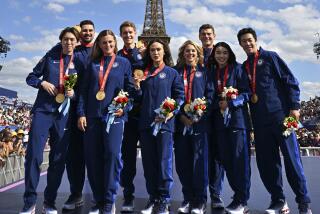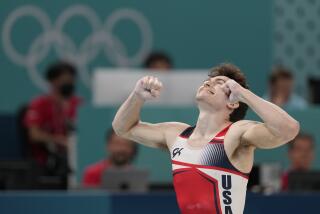America’s drought in the Nordic combined is over
- Share via
Reporting from Whistler, Canada — After all the years of disappointment, the glitches and near-misses, it took a miracle for the United States to win its first medal in the sport of Nordic combined.
Or maybe not.
Maybe Johnny Spillane’s historic silver in the normal hill/10-kilometer event at Whistler Olympic Park on Sunday was made of something grittier.
As Spillane said: “It took a lot of hard work.”
Hard work that carried him back from a string of injuries. Hard work that translated into his best ski jump of the year and had him leading the cross-country portion of the event down the final stretch.
In a thrilling finish, France’s Jason Lamy Chappuis edged Spillane by .04 of a second to win gold.
Though the American would have preferred to cross the line first, he pointed to teammates Todd Lodwick and Bill Demong, who finished fourth and sixth, respectively, in suggesting that something grander had transpired.
“What we hope for is that people understand this isn’t one day in four years,” he said. “It’s something we do every single day.”
Though combined might seem foreign to fans on this continent, the U.S. team has a relationship with the event dating to the 1920s.
The Americans improved from pathetic to respectable in the 1970s and ‘80s. In the mid-1990s, U.S. ski officials put together a plan to push for the next level.
It included creating a residency program in Steamboat Springs, Colo., that counted Spillane, Lodwick and Demong among its earliest participants.
They lived and trained together 300 days a year, with scant hope of fame or glory. As Lodwick’s wife, Sunny, explained: “There is some degree of frustration when not many Americans even know what Nordic combined is.”
The trio anchored a U.S. team that finished just off the podium at the 2002 Salt Lake City Games and scored some big international victories but struggled in Turin four years ago.
Coming into Vancouver, that put a monkey on their backs.
Things looked particularly rough for the injury-prone Spillane, who missed three months of training last year while recuperating from knee surgeries.
Yet the time off helped ease some of the pressure and expectations.
“That has been Johnny’s biggest enemy,” Demong said.
On Sunday, Lodwick and Spillane started fast, placing second and fourth, respectively, in the jump portion. Demong dug a hole for himself with a subpar result.
The pursuit race came a few hours later. Lodwick, a five-time Olympian who came out of retirement for one more shot at a medal, did most of the early work at the front of the pack. “No one wanted the lead,” he said. “So I pushed the pace.”
Demong joined the group but had expended too much energy catching up. Finally, Spillane moved ahead and, toward the end, tried to sprint away.
“I think I got it!” he yelled to Coach Dave Jarrett as he charged up the final hill. But that’s where his gauge hit empty.
“Johnny was far ahead of me and I honestly didn’t think I could get the gold,” said Chappuis, who was born in Montana. “Then he slowed down a little entering the stadium. . . . I knew I had the power to pass him.”
With the Frenchman taking the lead down the homestretch, it was all an exhausted Spillane could do to hold off Italy’s Alessandro Pittin, who finished third.
Not exactly a fairy-tale ending. But this wasn’t a fairy-tale race.
“We’ve worked really hard to get to this point where it doesn’t take anything special,” Spillane said of his team. “It just takes a good day.”
david.wharton
@latimes.com
twitter.com/
LATimesWharton
More to Read
Go beyond the scoreboard
Get the latest on L.A.'s teams in the daily Sports Report newsletter.
You may occasionally receive promotional content from the Los Angeles Times.







